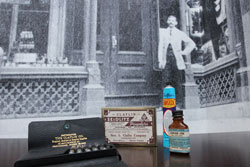Claflin Company celebrates 200 years of not doing the same thing
 The secret to longevity for independent regional acute-care distributors? “Stay nimble and alert to what is going on, not only within your company, but in the marketplace where you compete, and even the economy as a whole,” says Ted Almon.
The secret to longevity for independent regional acute-care distributors? “Stay nimble and alert to what is going on, not only within your company, but in the marketplace where you compete, and even the economy as a whole,” says Ted Almon.
Almon might be regarded an authority on the subject, as he is chairman of Warwick, R.I.-based Claflin Co., which celebrates its 200th birthday this year.
Claflin dates back to 1817, when Joseph Balch founded an apothecary in Providence, R.I. The Joseph Balch Company remained within the Balch family and flourished as J.B & Son until George L. and Arthur W. Claflin acquired it in 1873. Under the stewardship of the Claflin family, the George L. Claflin Company grew and by 1886 was recognized as the leading retail druggist and apothecary firm in New England.
In 1959 the company was sold by the family to a group of senior managers. Then, in 1976, as retirement age neared for this group of directors, the Almon Company acquired the business.
“The company’s long history is a point of pride and certainly something we use in marketing ourselves as a stable and viable choice of suppliers,” says Almon. “I think it also adds to our culture, esprit de corps, etc.”
But an illustrious history isn’t what defines Claflin.
Advanced logistics
 “I am particularly proud of our leadership position in advanced logistics practices, such as JIT/LUM, which we introduced to the industry as long ago as 1986, and have been able to maintain as a sustainable competitive advantage,” says Almon. “This took a bit of innovation, but a whole lot of courage, as it created a whole new business model for distribution in our industry. I am also very proud of the dedication and effort it took us to become the first ISO 9000-certified distributor in the industry, and to maintain that distinction over all these years.
“I am particularly proud of our leadership position in advanced logistics practices, such as JIT/LUM, which we introduced to the industry as long ago as 1986, and have been able to maintain as a sustainable competitive advantage,” says Almon. “This took a bit of innovation, but a whole lot of courage, as it created a whole new business model for distribution in our industry. I am also very proud of the dedication and effort it took us to become the first ISO 9000-certified distributor in the industry, and to maintain that distinction over all these years.
“And finally perhaps, I think the culture at Claflin is really exceptional. It is a very flat organization, where the closest player just picks up the ball. We use open book management; and have only team – not individual – incentive plans, exceptionally low turnover, and a pervasive positive attitude.”
It’s true that independents face their share of challenges today, but they are not insurmountable, says Almon. “To build a sustainable business, there must be a customer niche that the distributor can serve more effectively or efficiently than the larger, national firms with whom he must compete.
“For those customers who have become part of corporations or networks that are larger than our regional footprint, there is a problem,” he continues. “We probably need to refocus on those providers and networks that intend to stay within our region, and there are many of those.” In fact, he says, “in terms of convincing hospitals in our region that we are a solid choice as a prime vendor, that is really in our wheelhouse.”
A market in flux
Consolidation isn’t the only challenge facing independents today. Technology and other market forces are disrupting one channel after another, causing the marketplace to be in a state of flux, he says. “The rise of Amazon, and the seemingly endless flow of investment funding into the concept, is a good example of the challenges the independents will face.”
Then there’s healthcare reform – a challenge not just for independent distributors, but for all participants in the healthcare industry today.
“We have a federal law in this country – the Emergency Medical Treatment and Labor Act (EMTALA) – which since 1986 has mandated that every hospital must treat every patient that presents in their ED, regardless of their ability to pay,” says Almon. “To me, this says that the American people have decided that we are going to treat everyone in need. That being the case, we still have to figure out how to pay for President Reagan’s unfunded mandate.
“The current political discourse about healthcare has very little to do with quality or access to care,” he continues. “It is all squabbling about who will pay. The Affordable Care Act, while imperfect, did start a serious examination among health policy thought leaders about how to make the delivery system more efficient.
“I believe that payment reform initiatives started by the ACA are on the right track, paying for value rather than volume. Simply cutting spending in order to starve the healthcare beast into reform will simply deny care to many people in need, while allowing the delivery system to remain inefficient.”
Supply chain
Almon believes that providers and suppliers can play an important role in making the delivery system more efficient – if they can collaborate with each other.
“Far too many of what we now call supply chain executives still cling to a paradigm of old school purchasing agents, which saw the interaction between customer and vendor as adversarial,” he says. “This was based upon a belief that someone had to win and the other lose in every transaction. It can be difficult — even impossible — for some people to move past this mindset to a relationship of transparency, which allows all trading partners to win in a fair way.
“To be fair, vendors too need to work on seeing the continued prosperity of their customers — which depends on their operating efficiently — as a necessity to their own long-term success.”
Meanwhile, the role of the sales rep continues to evolve, though some facets remain constant, he says.
“My career started in sales and then sales education, and there are some seasoned axioms that still persist. ‘Nothing happens until somebody sells something’ is one. As much change as we may see, and as frustrating to the methods we have learned as this uncertainty may be, there are still customers, and they are still making buying decisions. Sales reps today cannot rely on any tried and true method.
“The reasons why it worked, and even the people it worked on, may have changed. There may be new tools needed to reach the people now influencing our business, and our job now is to figure out how to reach these new customers or decision makers. So the challenge to both the companies and their sales reps is essentially the same: Keep learning, don’t hunker down, stay positive, and don’t be afraid to try new approaches.”